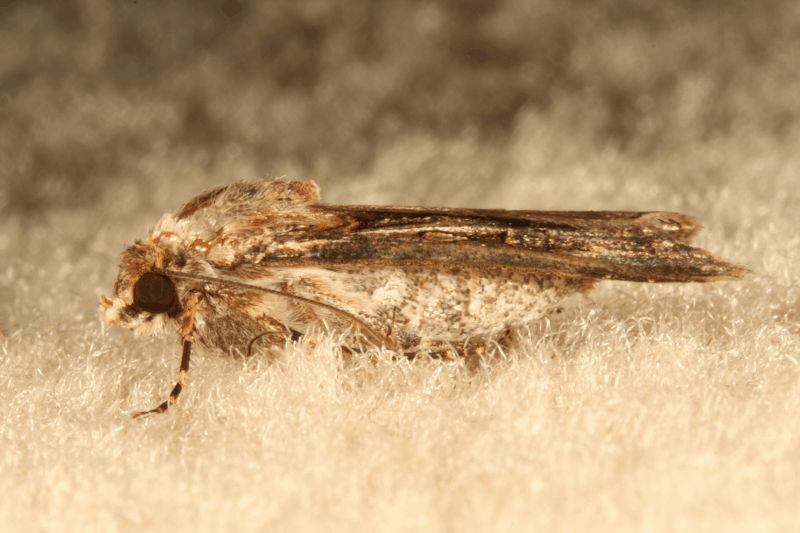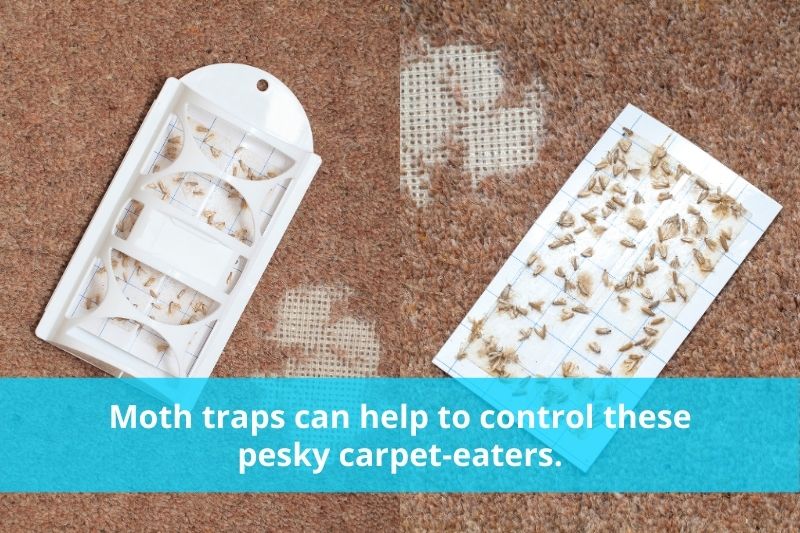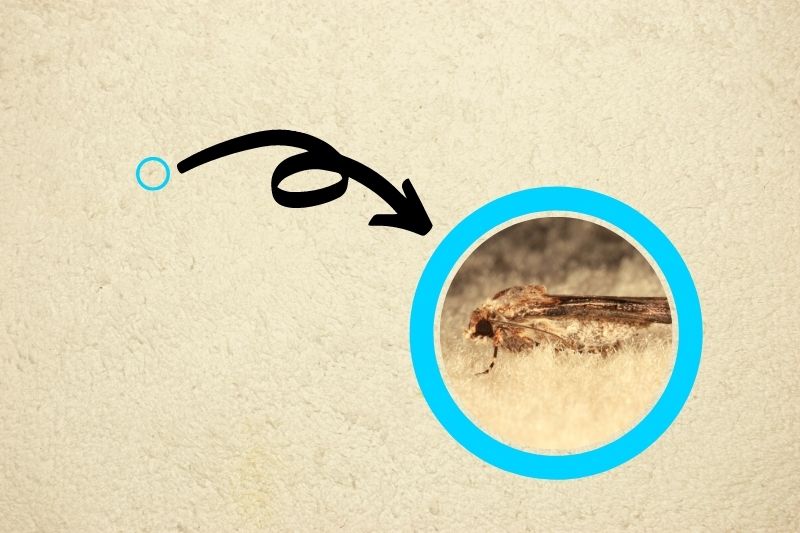Carpet moths are unwanted visitors. They come into the house and cause damage to everything they can reach, and they keep doing it until they’re eradicated!
When trying to get rid of these pesky little blighters, it is essential to find out what causes carpet moths in the first place. This way you can get to the root of the problem, and prevent these pests from persistently causing havoc in your home.
We’ve found out what causes carpet moths, so we’re going to share this information with you. This way, you can prevent the moths from coming into your home in the first place so you won’t fall victim to these tiny carpet eaters. And if you already have some unwanted tenants living in your carpets, we’ve got some tips for you too.
Read on to find out more.
What Do Carpet Moths Look Like?
Before you can find out the cause of a problem, you need to know exactly what type of pest you have in your home. Generally, a carpet moth has these identifiable features:
- About 5 mm in length.
- Brown/grey sort of colour.
- Has wings.
- Hops around the carpet.
- Wings have spots.
- Wings have hairy edges.
- Larvae leave their cases behind – Looks like a grain of rice.
- You might see them on the floor – You probably won’t see the eggs because they’re tiny.

If you see these types of things in your home, specifically on your carpets, then you know you’ve got carpet moths. So, let’s tackle the big question, ‘What causes carpet moths?’.
Causes
There are many possible causes of carpet moths, and some causes might surprise you. Here they are:
- Warm weather – The climate is warmer than it used to be, which means that it’s better for breeding, so you’re more likely to pick these carpet eaters up when you’re outside.
- Keratin buildup – Carpet moth larvae like to eat keratin, which is found in hair/skin, so they get attracted to wool, silk and fur, which just so happens to be the materials that carpets can be made from.
- Not vacuuming enough – Perhaps you don’t run the vacuum over the floors as much as you should, or maybe you think a quick squirt of air freshener will do… But, this isn’t quite good enough.
- House is too warm – Having the central heating up high creates a perfect, warm environment is wonderful for carpet moths, so they want to move in with you.
- Not dealing with the problem quickly enough – Once carpet moths get into your home they just keep on breeding. A single female can lay around 200 eggs at a time. If you don’t act fast you could have loads of carpet eaters working their way around your home.
Now you know the causes, you might be thinking, ‘How do they get in?’, read on to find out how.

How Do They Get into Your Home?
Carpet moths are traditionally found outdoors, but they’re making their way indoors and destroying lovely carpets everywhere. So, how do they get in?
- You bring them in yourself on your shoes.
- Pets bring them in.
- You might buy an antique that has a carpet moth infestation.
- Rugs given to you/bought from other people can already have a carpet moth problem, and you just invite the carpet moths into your lovely home.
You’ve got a pretty good idea about what causes carpet moths and how they get into your home, the next thing you want to know is how to get rid of them from your home. We’ve got solutions below for you.
Solutions
Carpet moths are incredibly annoying, but the good thing is you can get rid of them fairly quickly! Here are some solutions:
Address how the carpet moths are getting into your house
Find out how the carpet moths are getting into your home and put measures in place to limit the number of eggs that are being brought in. Here are some tips:
- Take your shoes off outside and clean them.
- Wipe your pet’s paws before they come in.
- Clean rugs that you get from other people before you bring them into your home.

Use traps to catch carpet moths that you might’ve found in your antique purchases – Stop them before they get out and onto your carpet. Try these:
-
- PRO TRAP- Moth Trap, 10 Traps With Pheromones – see on Amazon.co.uk
- Aries Moth Traps – see on Amazon.co.uk
- PIC Clothes Moth Trap – see on Amazon.co.uk
Home remedies
These may not yield the most significant results but they are things you could try if your moth problem is fairly new, and you’ve caught the issue early on. We do recommend that you try an actual product that has been designed to treat the problem though. But you can start here:
- Hoover your house regularly – Get right into the corners and dark places.
- Move your furniture out and clean everywhere – Disturb the eggs!
- Wash your carpet with bicarbonate of soda (also known as baking soda).
- Wash your carpet in white vinegar – This natural cleaner will kill off carpet moth eggs and larvae.
- Brush your carpet with a hard brush.
- Get some cedar-scented candles – Carpet moths aren’t keen on this smell. You can also buy cedar hanging scents to hang up around your home (they do work best in wardrobes/draws though).
Specific products
Products that are designed to treat this problem work very well. But, before you go ahead and use a product you should keep in mind that:
- You must follow the instructions on the package.
- You must keep pets and kids away from the room when you’re treating the problem.
Here are some examples of products that you can buy and use at home:
- Sprays/aerosol:
- Pest Expert Carpet Moth Killer Spray – See on Amazon.co.uk
- Zero In Carpet Beetle and Moth Killer Aerosol – See on Amazon.co.uk
- Fumigation kits (choose the level that suits your situation):
- Pest Expert Carpet Moth Killer Kit – See on Amazon.co.uk
Professional help
Nobody wants to have ruined carpets in their home. So, if you’ve tried the products and ideas above and nothing has worked it is now time to seek professional help.
Professional help will probably come at a price, but in the grand scale of things, it might be better to pay that little bit extra to get rid of the problem once and for all.
Things to keep in mind:
- Do your research.
- Find a reputable firm and use them.
- Ask questions.
- Find out what solutions they will use.
- Make sure you understand what is going on.
- Find out if the procedure will cause damage or harm to your home/furniture/kids/pets.
Different flooring
This might not be suitable for all of you, but you could try wooden flooring instead. It might not be as comfortable or as warm underfoot, but it’s an option. It’s also easier to clean this type of floor.
Don’t forget: You still have to clean this type of flooring, it’s not a ‘get-out-of-cleaning’ option. There will be plenty of bacteria and dirt collected on the surface.
Plus, you’d have to make sure that your moth problem was gone before putting down new flooring.

Carpet Moth FAQs
How often should I hoover my carpets to keep the carpet moths away?
You should aim to hoover your carpets at least twice a week. And when you hoover you really want to get into all the corners of the room, under the sofas, behind the TV, pretty much everywhere! Use all the extra bits that your hoover comes with to reach difficult spots.
How long do carpet moths live for?
Around 2 years. But, if you treat the problem properly, and keep on cleaning your home to prevent them returning, they won’t be around that long.
Should I thoroughly clean my house every month to make sure I don’t get carpet moths?
If you regularly clean your home then the chances of you getting carpet moths, or any other pest-related problem, will be much lower. You should clean all areas of your home regularly for basic hygiene reasons alone. You can use various cleaning products to effectively clean the different areas in your home. Check out our post on deep cleaning your entire home for more information.
Should I change to synthetic carpets?
Changing to synthetic carpets won’t stop carpet moths from breeding in your home. Although the material isn’t exactly what they desire, they’ll still try eating the dirt that’s been dropped on the carpet. This will still cause problems for you.
Do I have to move my furniture around the house to make sure I clean my carpets properly?
Absolutely! This is not negotiable. You won’t get rid of the problem until you do a thorough clean of your home.
What time of year will there be carpet moths in my home?
Carpet moths can put in an appearance at any time because they like the heat. In the summer it’s warm indoors, and in the winter, you’ll have the heating on to make it warm.

Bethan has a passion for exploring, reading, cooking and gardening! When she’s not creating culinary delights for her family, she’s concocting potions to keep her house clean!






